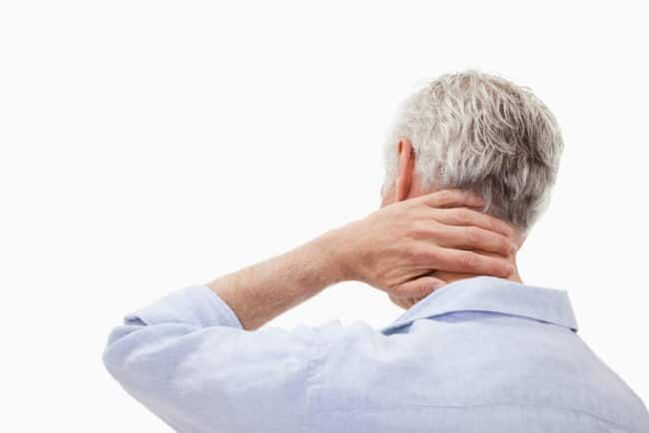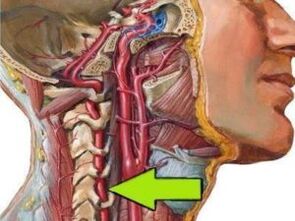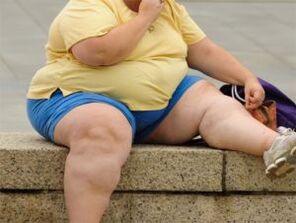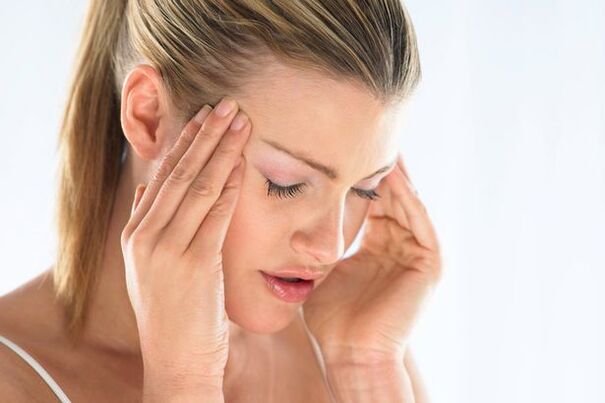Among all the pathological processes that affect the spine in its various parts, the cervical osteochondria is considered one of the most common and painful.This disease leads to many complications, mainly because it affects the spinal cord, and also adversely affects brain function.

What is cervical osteochondria?
The words of cervical osteochondicism in medical practice mean a progressive disease that affects this spine.This pathological process is characterized by degenerative duplicate processes in intervertebral discs, which are shock absorbers for cervical vertebrae.Degenerative changes in intervertebral discs are due to the fact that they are deleted and deformed.As a result, the distance between the vertebrae is reduced and the following consequences occur:
- Strait of the spine in certain areas of the spine.
- Passing the spine - large blood vessels that provide blood supply to the brain.Because the supply of the brain exacerbates and blood circulation to the cervical spinal cord is disturbed.
- The intervertebral discs can be deformed and flattened.This leads to compression of the individual parts of the spinal cord and nerve, more often, nerve roots are compressed.
All of these problems threaten not only violating brain blood circulation, painful sensations in the throat, headaches, etc. The development of cervical osteochondicity is dangerous with neurological problems, deterioration of the central nervous system.According to the international classification of diseases, several separate codes were assigned osteochondria of the cervical region.The disease code for ICB 10 depends on the age of the disease: the disease was diagnosed:

- M02 - dystrophy of intervertebral discs in adolescence.
- M42.12 is a dystrophic process on the throat in adults.
Many factors depend on the age of the patient and the degree of development of the pathological process, for example, the consequences, complications, symptoms and, of course, the principles of treatment.
Causes
Knowing the causes of the development of cervical osteochondicity can play a decisive role in the diagnosis process, as well as the determination of the principles of fighting the disease.However, before listing the reasons, it is worth saying that doctors distinguish two factors that lead to the development of this pathological process:
- Pathological - the destruction of intervertebral discs and other vertebrates with the involvement of nearby tissues, blood vessels and nerve beams in the pathological process under the influence of adverse external factors.The harder these factors and other pathologies, the faster the disease develops.
- Normal - based on the development of pathology, especially age -related changes.We are talking about the natural aging of cartilage tissues in the spine, salts, etc.
If we mention more specific causes of cervical osteochondralness are as follows:
- Violation of metabolic processes in the body, as well as certain stages of obesity.
- Subd these is a phenomenon characterized by a mobility restriction.These are not just injuries or diseases, this may also include a sedentary lifestyle and a seated job.
- Pathologies of the cardiovascular system, contributing to the weakened blood circulation in the brain, pressure changes and other things.
- Incorrect attitude, these are various forms of scoliosis, rheumatism and even flat legs.
- Injection of cervical spine.In this case, we are talking about sprains, strikes, bruises.Research of other spine in the development of cervical osteochondrication can affect the development of cervical osteochondry.
- Excessively large physical activity in the cervical area caused by intense sports or heavy physical difficult, depending on the type of human activity.
- A sedentary lifestyle is also dangerous with a steady tendency of the cervical spine and the entire spine, if they sit incorrectly or in uncomfortable furniture.
- A cervical spine hernia, as well as various related diseases.
- Forced long -term possession of the head in an unpleasant or unnatural position.In this case, not only the overseas muscle occurs, but the spine is also a curve in the cervical area.
- Doctors consider stable anxiety and nerve exaggeration a very common cause.
- One of the reasons is also considered congenital abnormalities in the structure of the spine.

What is the risk of health?
As mentioned earlier, in the cervical spine, not only the spinal cord and various nerve branches, but also the spinal arteries that provide the occipital part of the brain, cerebellum and brain.With the development of cervical osteochondicity, the close tissues are inflammatory.In addition, the development of pathology threatens to squeeze nerve roots and transmit blood vessels, the consequences are as follows:
- The osteochondria is accompanied by spine deformations, the consequence of which the branch -channel is limited to certain areas.This can lead to compression of the spinal cord and nerve branches, which promises serious neurological problems.In severe cases, a person feels pain, even there is a chance of loss of control in individual parts of the body (mainly in hand or face).
- The squeeze of the throat vessels, as already mentioned, is accompanied by a violation of blood circulation in the occipital area of the brain.At the same time, the brain ceases to receive oxygen and nutrients in the required amounts, begins oxygen hunger.With circulation disorders, there is a real risk of ischemic stroke and various neurological pathologies.
Syndromes
The main syndromes are:
- Spinal.
- Spine artery.
- Koreshka.
- Cardiac.
It is important to know that each of these symptoms is accompanied by painful sensations of a different nature, as well as many adverse clinical indications.A person can feel dizzy, a noise appears in his ears and much more.

Vertebral syndrome
He talks about the direct connection of cervical osteochondicity with bone and cartilage tissues.Symptoms in this type of pathology are also linked to damage to the aforementioned tissues:
- Neck movements are partially or completely limited.
- Head movements are accompanied by throat pain.
- The x -ray has morphological changes in the tissues (intervertebral and vertebrae body).
It is worth noting that the spine is always accompanied by these three clinical signs.If at least 1 of them is absent, the diagnosis will be completely different.
Rook syndrome
It occurs when the spinal cord roots are damaged.At the same time, nervous conductivity is disturbed, a person may feel pain or lose the sensitivity of individual parts of the body or even suffer from paralysis.Depending on which of the 8 radical couples there is a conductivity disorder, these symptoms are distinguished:
- 1 pair - numbness or pain in the back of the head.
- 3 couple - Violation of reflex chewing, tongue numbness and unpleasant sensations behind the ears.
- 4 pair - Pain in the clavicle, violation of reflex ingestion.
- 5 pair - shoulder breaches, accompanied by the problem of hand movement.
- 6 couple - the patient begins to feel pain and numbness in the forearm and shoulders.
- 7 couple - hands and fingers go numbness (often index and middle).
- 8 pair - problems similar to the past, but numbness is felt on the finger of the ring and on the little finger.
Cardiovascular syndrome
Although the pathological process is still located in the cervical spine, the syndrome has all signs of heart pathologies.The clinical picture is as follows:
- Rapid pulse.
- Pain in the sternum area.
- Breathing plan, weakness, lethargy, reducing performance.
Signs and symptoms of cervical osteochondicity
For the timely search for a doctor, it is necessary to clearly understand the signs of cervical osteochondry.In some cases, this knowledge allows you to seek help in the early stages of the disease when it is easier to deal with.In general, the symptoms for cervical spine osteochondria are as follows:

- Pain for osteochondria is always present, only intensity and frequency vary.It is the pain that is the first clinical sign.Their intensity depends on the stage of developing the disease, in nature is stupid or compressed.Painful sensations are mainly in the neck of the occipital area, but they can also radiate in the time area, shoulder belt and hands.
- In most cases, there are manifestations of the damage to the vestibule.We are talking about frequent causal dizziness, nausea, reduced coordination of movement, uneven walking, loss in space.
- One of the most common clinical symptoms is the rigidity of the throat muscles and the stiffness of movements.It is difficult for a person to turn, lower and throw their heads away, movements respond with periods of pain.
- Many patients note the feeling that gooseberries "run through the scalp" or a characteristic stinging is noticeable.
- There is muscle weakness and numbness in the hands.
- Often there are psychological manifestations that are expressed in depression, drowsiness, abrupt change in mood, temperament or irritability.
- Due to the reduced blood circulation and damage to the brain tissue, the dizziness exacerbates and the noise in the ears appears, similar to the rusty, the pulse, the blow.
- Most patients have vision dysfunction, as well as eye pain, especially when trying to cut their eyes to the left, right, up or down.
It is sometimes possible to determine the degree of development of the pathological process with symptoms.However, for a complete diagnosis of this, this is not yet enough and various diagnostic measures are required.
Diagnostic methods
The diagnosis of cervical spine osteochondalism is essential for identifying the detection and stage of the progression of the disease.For complete diagnosis, such diagnostic methods are required:
- X -Ray - The main method that allows you to determine the degree and detection of spine deformation.
- You can use computed tomography for a more accurate diagnosis of pathological changes in vertebrae and intervertebral discs.
- MRI (Magnetoresonance Imaging) - enables the wheels and vertebrae to be examined in detail, to determine the presence of hernia, protrusions and lesions of the rest.
- Doplerography - At the same time, the examination becomes the opportunity to find a space for compression of the artery, evaluates the degree of circulatory disorders.
Treatment methods
Treatment of neck osteochondicity always involves a comprehensive approach.The principles of treatment depend on the mass of factors, such as the patient's age, the stage of developing the disease, the brightness of the clinical picture, etc. However, you cannot do without a doctor in this condition and first of all you can consult a therapist who will direct you to a sponel.In terms of integrated approach: The cervical osteochondrial osteochondria is treated using pharmaceutical therapy, physiotherapy, massage, exercise therapy and other methods that need to be discussed in more detail.
Medication
The basis for the treatment of cervical osteochondralism is pharmaceutical therapy, which includes the use of tablets, medicines and medicines of such groups:
- Anesthetic - analgesics and anticonvulsants.Formerly dull nerve centers, thereby stopping the painful sensations.The latter allows you to relieve throat muscle spasms, create blood flow and suppress pain.
- NSAIDS -The non -staloid anti -inflammatory drugs are essential for reducing the inflammatory process, most of them also eliminate pain.Often these drugs are used in the form of gel, ointments that rub in the affected area.
- Musorelaxants are another way to remove muscle spasm in the cervix area.
- Chondrop Protectors are mandatory at certain stages of bread osteochondrialization because they help restore bone tissues.
- B Vitamins - Normalize the metabolic processes of nerve tissues by improving the conductivity of nerve impulses and contributing to the work of the central nervous system.
Remember, treatment should only be performed under the supervision of a doctor who is responsible for the appointment of each medicine, as well as for determining the duration of his intake and dosage.
Physiotherapy
Treatment of neck osteochondicity will often be more effective using certain physiotherapy techniques:

- Electrophoresis.
- Laser treatment.
- Ultrasound.
- Massage.
Massage therapy is necessarily performed by an experienced health worker, treatment is performed by a course of at least 10 sessions.Cervical massage massages help normalize blood circulation, restore elasticity, muscle tone, pain relief, etc.
Manual treatment
Manual treatment is based on the principle of restoring engine functions and mobility between vertebrae.Initially, the manipulations are in a light relaxing massage, then the doctor gives more and more strength, acts on the pressure vertebrae and neck turns.
The use of Kuznetsov applicants is one of the methods of treatment for spine diseases, including osteochondricular.The effect of adaptation to the cervical area smooths metabolic processes, relieves pain, increases muscle tone, improves blood circulation, increases nervous tissue conductivity, etc. To prevent osteochondria, it is useful in 2-3 minutes.


























































































